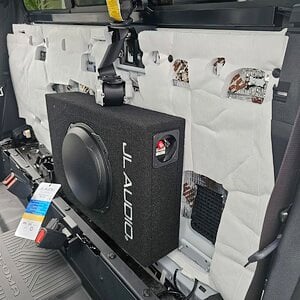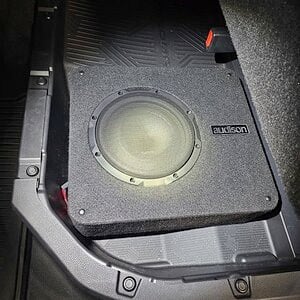Long story short my friend had an alpine type s and an alpine type r (both 12s and type r is not his). one day he gave the type r back to my other friend and didn't say why, After a few days we started to think he blew his amp. Last night he came out to me and said that he blew out 1 channel in his 2 channel amp and that now instead of having the 2 subs bridged he told me he has his D4 type s wired at 2 ohms. Now my question is I thought you couldn't wire 4 ohm subs to 2 ohm. am I right? cause I told him this and he changed his story from him having something special going on and that that's why he can wire it at 2 ohms to trying to convince me that there is a special way to wire it.
You are using an out of date browser. It may not display this or other websites correctly.
You should upgrade or use an alternative browser.
You should upgrade or use an alternative browser.
RickJamesYo
Member
Indeed he can run it at 2 ohms, just wired in parallel: + to + to + and - to - to -. As long as the amp is 2 ohm stable he shouldn't have a problem.
t-money 10+ year member
CarAudio.com Elite
Single subwoofers with single coils can be wired to their impedance. For example, a SVC 2-ohm sub can be wired at 2 ohms.
Your friend is currently running a single DVC sub, that mean it has, well, dual voice coils. This means you can wire it in parallel or series to get the impedance you want. Wiring in parallel will cut the resistance in half, leaving your final impedance at, say, 1 ohm if it's a 2 ohm sub. If you wire a 2 ohm sub in series, that basically doubles the resistance load at the amp, which means it'd be now running at 4 ohms. It's confusing at first, I know.
Now, when you're running 2 dual voice coil subs, you're able to see more and more options opening up. So, say you've got 2 2-ohm DVC subs. Remember what I said about doubling and cutting impedances in half when I was talking about series and parallel wiring? This now applies for both subs. So, if you're running two, you can run both in parallel, which will cut the impedance in half twice. (2 divided by 2, divided by 2 again), this will give you a final impedance of .5 ohms. You could also run series/parallel, which would cut the impedance in half but then double it, leaving you where you started - at 2 ohms. Now, your final option is to run series/series, which would double it twice (2*2*2) leaving you at 8 ohms. This option is somewhat rare because of the high resistance loads put on the amp, meaning you won't get near as much power out of it. This same concept can be applied to any subwoofer configuration.
SVC and DVC subwoofers offer different options, and some subs even have more. But I mainly wanted to explain the DVC one because these are by far the most common type of sub, and it's probably what you'll deal with the majority of your time in car audio.
I hope this helps.
Your friend is currently running a single DVC sub, that mean it has, well, dual voice coils. This means you can wire it in parallel or series to get the impedance you want. Wiring in parallel will cut the resistance in half, leaving your final impedance at, say, 1 ohm if it's a 2 ohm sub. If you wire a 2 ohm sub in series, that basically doubles the resistance load at the amp, which means it'd be now running at 4 ohms. It's confusing at first, I know.
Now, when you're running 2 dual voice coil subs, you're able to see more and more options opening up. So, say you've got 2 2-ohm DVC subs. Remember what I said about doubling and cutting impedances in half when I was talking about series and parallel wiring? This now applies for both subs. So, if you're running two, you can run both in parallel, which will cut the impedance in half twice. (2 divided by 2, divided by 2 again), this will give you a final impedance of .5 ohms. You could also run series/parallel, which would cut the impedance in half but then double it, leaving you where you started - at 2 ohms. Now, your final option is to run series/series, which would double it twice (2*2*2) leaving you at 8 ohms. This option is somewhat rare because of the high resistance loads put on the amp, meaning you won't get near as much power out of it. This same concept can be applied to any subwoofer configuration.
SVC and DVC subwoofers offer different options, and some subs even have more. But I mainly wanted to explain the DVC one because these are by far the most common type of sub, and it's probably what you'll deal with the majority of your time in car audio.
I hope this helps.
Activity
No one is currently typing a reply...
Similar threads
the AVIC was a tad more complicated to wire not to mention stuffing it in a smallish stereo hole. thanks for advice.
- Started by HandsomeSteve
- General Car Audio
- 8
- 318
Sweet!!!!!
- Started by ikpthegame
- Wiring, Electrical & Installation 2
- 20
- 915
Drill a hole and use the proper protective split loom and hole grommets to keep the outer speaker jacket from knicks and cuts, give just enough...
- Started by Red Dog
- Wiring, Electrical & Installation
- 8
- 798
It mostly comes down to weight. You can have a super lightweight cone, soft suspension and aluminum coil on a sub and you pretty much get a pro...
- Started by MrButtersworth
- Subwoofers
- 4
- 811
Yes . Until i get a 3.5 or 4 inch mid
- Started by Bass so loud it HZ
- General Car Audio
- 4
- 760


